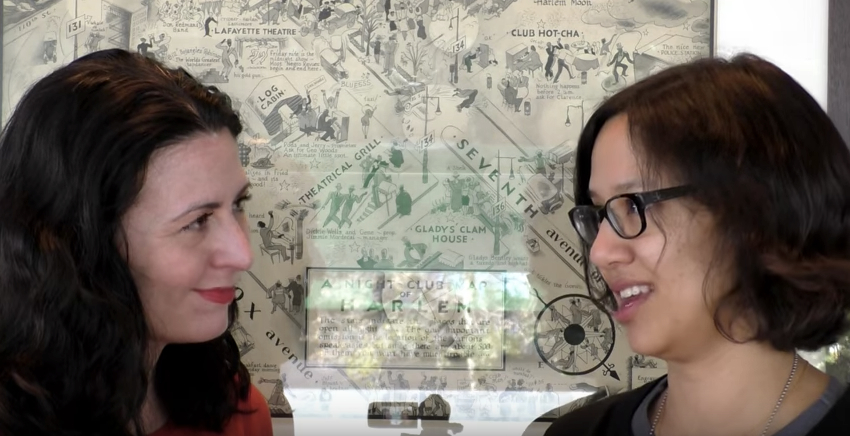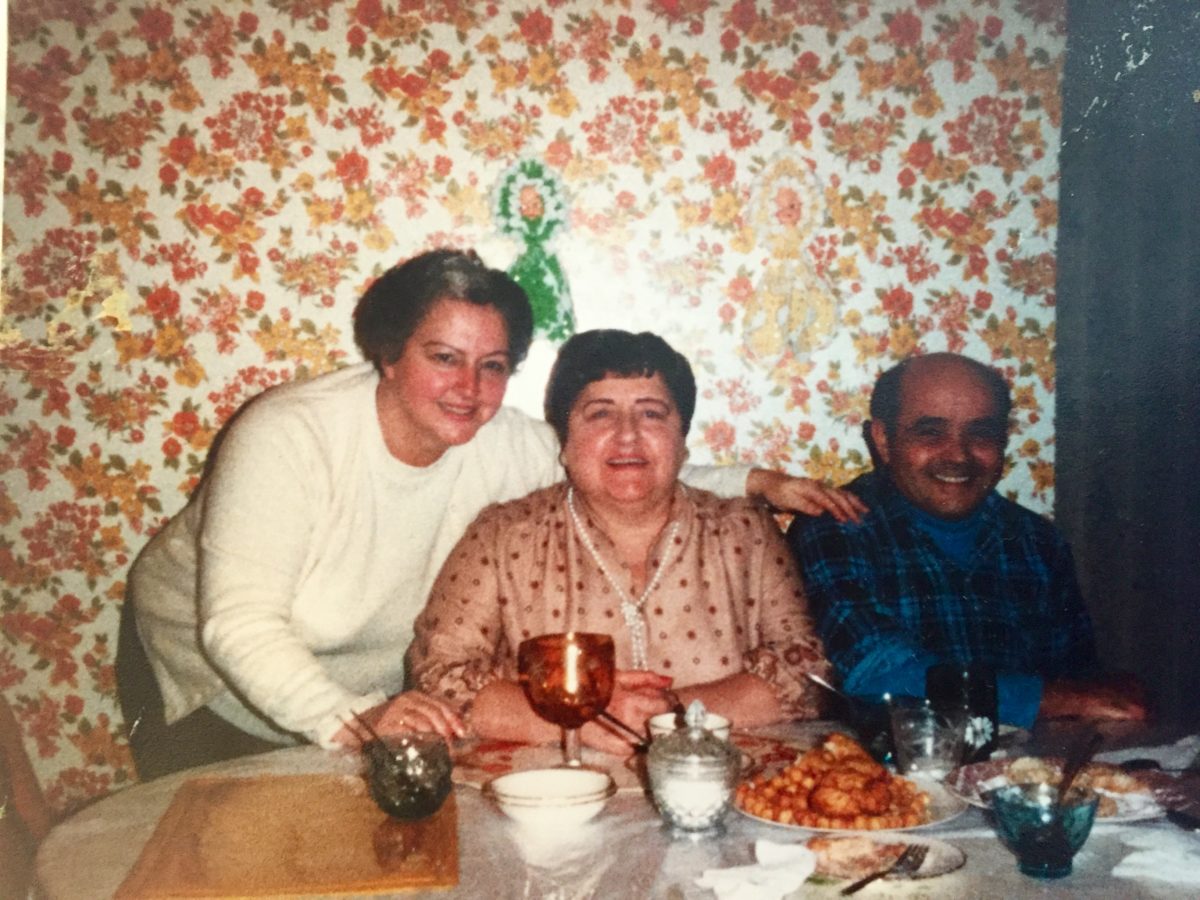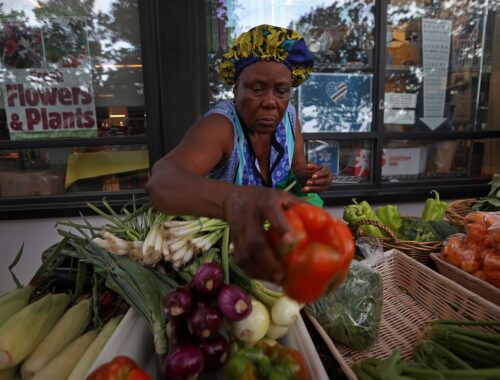
Jocelyn Ruggiero’s SNIPPETS: Melissa Barton, author, Gather Out of Star-Dust: A Harlem Renaissance Album
Jocelyn Ruggiero interviews Melissa Barton, Curator, Prose & Drama, Yale Collection of American Literature. Barton is the author of the new book Gather Out of Star-Dust: A Harlem Renaissance Album, and the curator of Gather Out of Star-Dust: The Harlem Renaissance & the Beinecke Library, a major building-wide exhibition, on view in New Haven, Connecticut, through April 17, 2017.
Interviewed March 9, 2017
Transcript:
Jocelyn: Hi, I’m Jocelyn Ruggiero and this is Snippets. Today, I’m talking to Melissa Barton. Melissa Barton is the curator of drama and prose for the Yale Collection of American Art. She is also the author of this wonderful new book by Yale Press, it’s called Gather Out of Star-Dust: A Harlem Renaissance Album. She is also the curator of an exhibition of the same name here at Yale’s Beinecke Rare Manuscripts Library. Hi.
Melissa: Hi.
Jocelyn: Thank you for talking to me today.
Melissa: It’s my pleasure.
Jocelyn: I really enjoyed this book. I learned so much. And for me, the way you’ve structured it was so important in my understanding of the story, the narrative of the Harlem Renaissance, it was really illuminating.
Can you tell me about the different sections, what the different sections were, and why you started with the one you started with?
Melissa: Sure. I was thinking I wanted to do a book that showed 50 objects from the collection related to the Harlem Renaissance and I was trying to figure out a good way to organize those things. I knew also that I wanted the title of the book to have the word “gather” in it. I had already decided that and then I kind of came upon this idea that oh, my gosh, I could organize it… I made a map of Post-it notes on the wall in my office and tried to figure out all these things.
I figured out that I could use synonyms for the word “gather” to organize five sections of the book. And so, I started with the section called “Muster,” where I’m talking really about some of the beginning moments of this period and some of the reason which all the right forces aligned really to make this moment possible. I start the book with photographs of a very I think underknown protest called the “The Silent Protest Parade” which was enacted in 1917 by then National Association for the Advancement of Colored People in response to these violent attacks on African-Americans in East St. Louis.
It’s estimated that 10,000 people marched down Fifth Avenue in New York City in Midtown not in Harlem, between Central Park and Madison Square.
Jocelyn: In silence?
Melissa: In silence.
Jocelyn: The photographs are very powerful.
Melissa: It’s a really chilling thing to imagine. I knew I wanted to start with that and I thought “muster” would be a really great word to use to describe a peaceful protest but really this time of people coming together to prepare to do something.
The last section is called Collect. The exhibition is really focused in some ways on the formation, the ways the formation of libraries were instrumental in capturing the history of the Harlem renaissance in the very moment that it was going on.
Jocelyn: Informally, right? It seems like there was a lot of informal collecting going on.
Melissa: There was informal collecting and there was formal collecting as well. The part of the New York public library that’s called the Schomburg Center was actually founded in this time through a donation of a collection of books; it was a purchase. All the creation of these libraries and the creation of these more informal collections is a really big part. So I kind of have those as bookends.
Getting Together. The idea of a get-together was one that I really wanted to emphasize, the friendships. I was working with some of this material with students yesterday and one of them remarked to me how amazed she was that these writers were not more competitive with each other. I was like that’s really true, they were really friends, and working together, and cheering each other’s victories.
Jocelyn: I was surprised by what you talked about. You quoted a statistic, I can’t remember it exactly, about the number of African-American writers published during this time period compared to the decade prior.
Melissa: Yes, that quadrupled. I don’t remember the exact numbers either but it was about four times many. Publishers that we now recognize as kind of the vanguard of American literature at that time were really taking notice of African-American writers, so the Knofps, Boni & Liveright,Harper, some really prominent publishers were publishing African-American writers.
Jocelyn: Tell me more about these gatherings because they were taking place in all different places. Why I asked you about the muster section first is because I had no idea that the formation of the NAACP preceded this and all this political activism, it seemed of course that was the foundation of what was to follow. How do you see those social and political events leading into these gatherings?
Melissa: I think the movement was very self-conscious, so there was a real awareness that something was going on. Historians now mark certain very important dinner parties as being really central to kind of the networks that were created.
Charles Johnson, who was the editor of Opportunity magazine, which was the magazine of the National Urban League, he organized a dinner—the ostensible purpose of the dinner was to celebrate a new book by Jessie Redmon Fauset who was an African-American novelist, she was also the literary editor of the Crisis magazine.
He then invited not only all of the members of what he called the younger group of African-American writers but then all of these kind of downtown Greenwich Village tastemakers he invited also. Eugene O’Neill was invited to the dinner, Edna St. Vincent Millay. He had all of these people together and then there’s this big celebration of like wow, look at all these publications, look at all this great poetry that’s coming out, look at this novel, and this novel, something really big is going on here and they’re kind of able to say that through the force of these gatherings.
And then, at that gathering is when Paul Kellogg decides to do a special issue of Survey magazine about this movement, Alain Locke edited that and that turns into the book, The New Negro which is a tremendously important book marking this period. It’s in itself little collection, right? It’s an anthology. So that’s an important aspect of that as well.
Jocelyn: I had no idea there were so many publications in magazines that you show in the exhibition and in the book that I had no idea there were so many, like you said, so many opportunities for young writers in multi-generations too were gathering, right?
I love this. Will you tell everyone what we’re standing in front of?
Melissa: Sure. It’s called A Nightclub Map of Harlem. It was drawn by E. Simms Campbell, who was a professional official illustrator who primarily worked for Esquire Magazine. This illustration was published as a spread in a magazine that was very short-lived called Manhattan: A Weekly for Wakeful New Yorkers.
And then kind of gained a lot more popularity and had a kind of second life because it was published in the seventies as the end papers to Cab Calloway’s autobiography because Cab Calloway is featured right here.
It’s this hilarious, very tongue in cheek…
Jocelyn: It’s very cheeky. You can’t see it well in the video but come to the exhibition or get the book, it’s wonderful, it’s very cheeky.
Melissa: Very tongue in cheek kind of portrayal of Harlem nightlife t’s traffic jam up here, people from downtown, white patrons trying to get into Connie’s Inn, that kind of thing is going on. The police are playing cards in the police station and talking about the illegal gambling that’s going on outside. There’s a lot of jokes.
Jocelyn: This actually brings me to another thing that I learned. I did not realize that the Cotton Club did not serve black patrons.
Melissa: Yes, that’s correct.
Jocelyn: I know that in popular culture, what most people know of the Harlem Renaissance, the Cotton Club and those entertainers are one of the first things everyone thinks of. You really talk about that in this book and of course this Harlem Renaissance had to have another aspect of these people driving up from Fifth Avenue, white patrons, to go to certain clubs and that was really illuminating.
Melissa: The famous Irving Berlin song Puttin’ On The Ritz is about that. It’s about going uptown to Harlem and there’s older original lyrics that many people don’t know that talks much more explicitly about that, going uptown to Harlem to party essentially.
There were plenty of clubs and speakeasies that of course did cater to African-American patrons as well, there was a real combination and I think everybody was trying to get like a piece of that experience. Much in the same way that underground popular culture now becomes much more mainstream popular culture.
Jocelyn: Is there anything you learned in putting this book together or any insight you had that you didn’t have before just seeing all this work gathered together?
Melissa: I think I definitely learned a lot factually. I knew a little bit about this period and I had also read a lot of criticism about this period because it’s part of my specialty, but I learned a lot more. I learned a lot more about this idea of conscious structuring of the movement by this leadership in the course of it.
And I think that idea of the collective and of collecting, there’s something I’m still trying to figure out for myself, like are those things related or are they just metaphors for each other? I’m trying to figure that out. I’m still interested in that.
Jocelyn: The title of the exhibition comes from a Langston Hughes poem, can you talk a little bit about that poem and why you felt it was the appropriate title for this exhibition of work?
Melissa: Sure. I wanted the word “gather” to be in the title of the book because I think I wanted to stress that this movement was as much a social movement and was really about these groups of people working together, collaborating and so I just took out my Collected Poems of Langston Hughes and looked through the first line index to find a poem that started with the word “gather” and came across this one. It’s a little later. Dream Dust is the name of the poem. It was published in 1947, which is a little later than this period but I thought that idea of stardust is such a beautiful, charming concept and it seems really to fit with this period and the allures of this period that many people recognize. And of bringing together something bigger out of smaller things. It seemed to fit really well.
Jocelyn: It fits perfectly. That’s why I asked you because again, for me reading this book and then coming to the exhibition really brought together the whole narrative of this period that is really illuminating. Thank you so much, it’s been wonderful talking to you and I highly recommend everyone get this book from Yale Press, come see this exhibition, it’s really, really, really stunning. Thank you.


